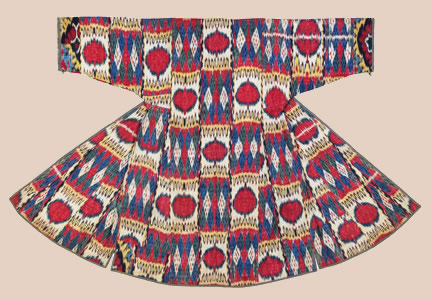Colors of the Oasis: 19th Century Central Asian Textiles and Their Modern Revival

Bruce Baganz
Thursday, March 2, 2017
The Coffee House Club
Bruce P. Baganz is president, board of trustees of The Textile Museum in Washington, DC. He is also the the co-chair of the board of the George Washington University Museum, chairman of the Near Eastern Art Research Center, and a member of the board of the National Trust for the Humanities. Bruce is a recipient of the Joseph V. McMullan Award for scholarship and stewardship in Islamic rugs and textiles, and is the 2015 recipient of the George Hewitt Myers Award for lifetime achievements in the textile arts, recognized as the highest international accolade in the textile arts. Bruce is also a longtime member of the Hajji Baba Club.
Central Asian ikat textiles are recognized today for their inventive designs, clever color combinations and dazzling palettes. They have been prized for their aesthetic beauty for two centuries, and the influence of ikat designs can be seen today in contemporary fashion and home decor.
Ikat textiles derive their name from an ancient technique where yarns are protected to resist dye penetration. Central Asian ikat is a warp-faced fabric, in which all colors are applied to silk warp yarns in a multi-stage tie-resist method before the textile is woven. The creative process is complex, requiring skilled designers, dyers, weavers and other specialized craftsmen. These silk fabrics were created without benefit of printing presses, complex looms, or the machinery of the industrial revolution.
The early years of the 19th century saw remarkable artistic development of ikat production in the Central Asian oasis cities of Bukhara and Samarkand, and in the towns of the Ferghana Valley. Ikat fabric was soon in great demand both in local ethnic groups, and in the export market, being used for opulent costume and decorative hangings.
The Textile Museum in Washington, DC is privileged to have two splendid collections of 19th century Central Asian ikats. The 2005 donation by Murad Megalli comprises Colors of the Oasis: Central Asian Ikats and is gorgeously documented by Sumru Krody and other contributors. In 2015, Guido Goldman donated his 100 personal favorite ikats from his glorious collection that was assembled with foresight and taste. The Goldman Collection, Ikat: Silks of Central Asia remains today as the outstanding textile-themed publication of a generation with text authored by Kate Fitz Gibbon and Andrew Hale.
Highlights of the Megalli Colors of the Oasis, Goldman Ikat and other private collections illustrate the range of artistic design that encompass the best of Central Asian ikat textiles. Photographic images drawn from 19th century archives provide context to the historical significance of these textiles of the region. Today, a modern revival in ikat creation in the Ferghana Valley demonstrates the complex techniques required to produce these textiles, which are popular in contemporary fashion and decor.
